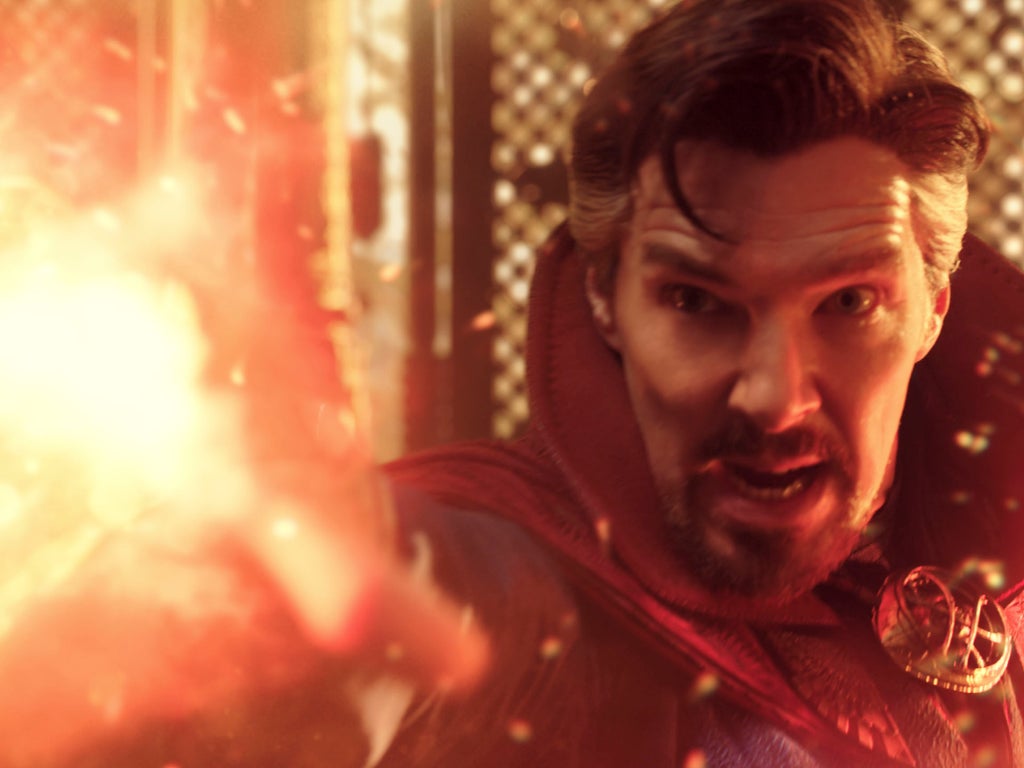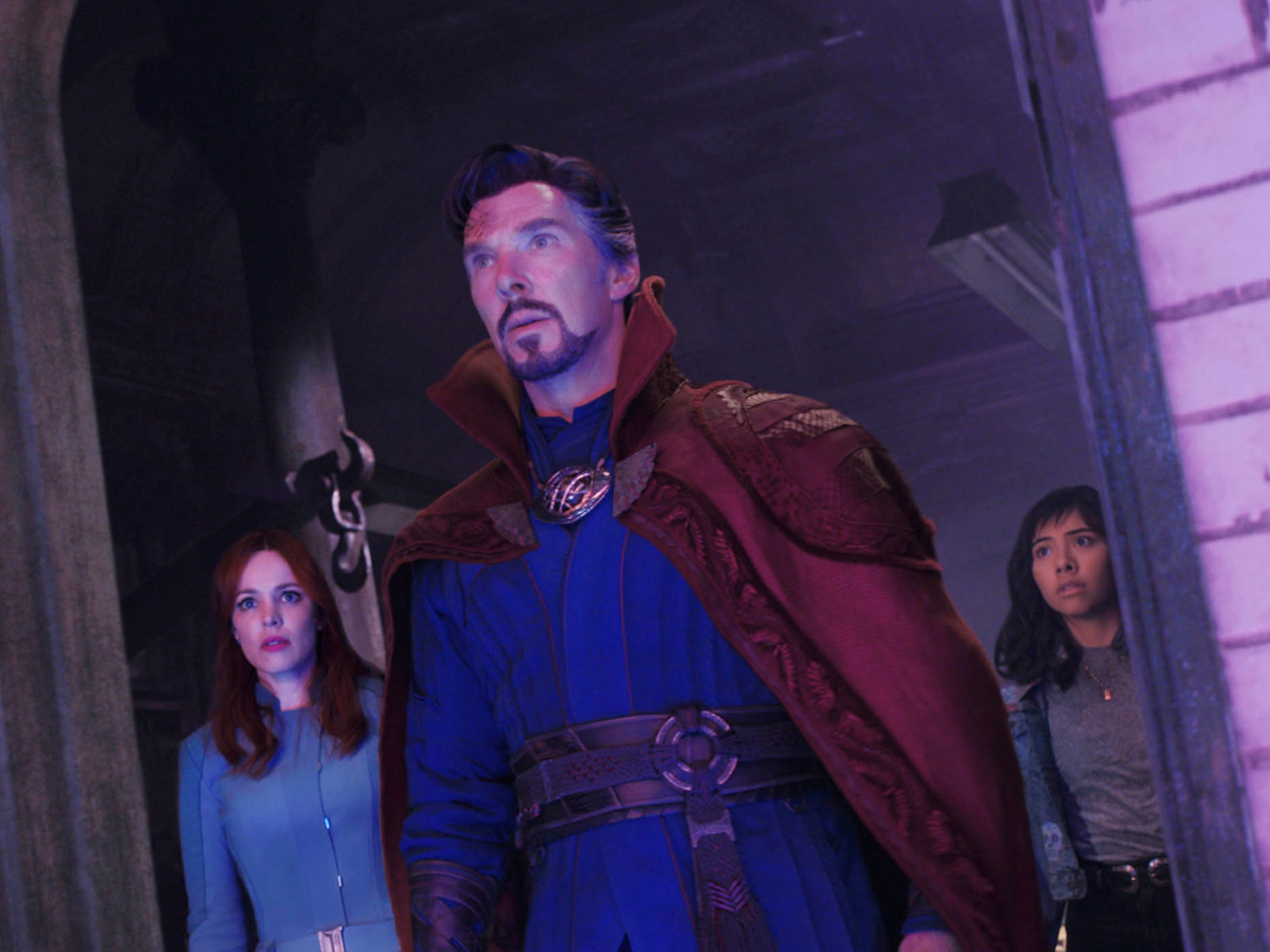
Dir: Sam Raimi. Starring: Benedict Cumberbatch, Elizabeth Olsen, Chiwetel Ejiofor, Xochitl Gomez, Rachel McAdams, Benedict Wong, Michael Stuhlbarg. 12A, 126 minutes.
I’d always thought that the appeal of the multiverse lay in its infinite possibility. Imagine the only limit to existence being the breadth of our own imagination – that anything we could conjure could be out there, birthed into existence in an alternate universe. Well, thank you, Marvel, for showing me how wrong I was. It turns out that the point of the multiverse, and of Doctor Strange in the Multiverse of Madness, isn’t its creative potential. It’s its cameos. A million universes could exist, and they’d all contain surprise appearances by people and things fans can hoot and holler over, before being purchased as toys on the way out of the cinema.
Doctor Strange in the Multiverse of Madness is, essentially, Spider-Man: No Way Home minus all the rose-tinted nostalgia or the one-man charisma machine that is Andrew Garfield. It also has not one ounce of the fun with its central conceit that 2018’s Spider-Man: Into the Spider-Verse did, minus a single sequence where the magically endowed Doctor Strange (Benedict Cumberbatch) finds himself tumbling through portal after portal, universe after universe. There’s one still ruled over by the dinosaurs. One where people are made up of paint splatters. Another that’s entirely two-dimensional. The audience gets to wave at them as they go by, before Strange returns to the same New York City street set with a little extra CGI in the background.
Any opportunity to really put the “madness” in this multiverse is spoiled by the crowded, intersecting desires of its three main characters. Strange, having already broken the multiverse once in No Way Home, is still navigating the same struggles he’s been tussling with since his 2016 solo film – weighing up personal responsibility and personal risk. Wanda Maximoff (Elizabeth Olsen), meanwhile, has fully shifted into the wilful and tragic “Scarlet Witch” persona she discovered in last year’s limited series WandaVision, which aired on Disney+ (yes, if you haven’t kept up with the TV shows, this film will not grant you any mercy). She will stop at nothing to be reunited with the two sons she conjured into being with her mind. A brand new hero, America Chavez (a likeable Xochitl Gomez), has also randomly dropped out of a portal. As we soon discover, she has a tendency to hop universes whenever she’s put under duress.
The film kicks off with a heavy exposition dump, but then begins to buckle further and further under the weight of its vast lore and magical MacGuffins. There are two very important spell books – one good, one bad – and an exhaustive string of weapons, names, legends, and committees. But it’s hard to find much joy in that level of world-building when Multiverse of Madness is dominated by two feverish, chaotic feelings: watching MCU head Kevin Feige try to lay the foundations for the next phase in his grand franchise plans, and simultaneously trying to tie up loose ends from what’s come before.
But these are structural loose ends, not emotional ones. While screenwriter Michael Waldron deployed delicate character work in his recent MCU TV series Loki – starring Tom Hiddleston – here he is practically a construction worker, mechanically figuring out how this person can connect to that person, rather than allowing individual fears and desires guide the film’s leads. Strange is still, for example, pining after Christine Palmer (Rachel McAdams), despite her character having basically dropped off the face of the planet after his solo film. And not in the literal, snapped-by-Thanos kind of way.
With the reintroduction of Natalie Portman’s Jane Foster in the forthcoming Thor: Love and Thunder, this really does seem to be part one of Marvel’s “sorry we forgot about all the female love interests” apology tour. But it’s hard to build on a relationship that ultimately hasn’t been of central concern to Strange. He is, after all, a guy still wrestling with the fact he helped temporarily obliterate half of all life in order to ultimately save the universe.

Yet the biggest victim of Multiverse of Madness’s machinations is Olsen’s Wanda. A side character who spent most of her time on screen having nothing but misery inflicted on her, she was finally granted depth and emotional richness in WandaVision, only for Multiverse to whittle her down to the single character trait of “desperate mother”.
She embodies an odd assumption that the MCU has been repeatedly guilty of making – that if we’ve been given a single opportunity to bond with a character, that in-built affection alone will be enough to carry us through every future contractual appearance. And it’s a particular shame for Olsen herself. Remarkably, she still delivers as raw and honest a performance as you can while floating in front of a green screen repeating the same variation of “I’m not a monster, I’m a mother” ad nauseam.
With all of that in mind, the hiring of Sam Raimi feels almost like a distraction – a clever one, but still a distraction. Multiverse of Madness gives us what many MCU fans have been clamouring for: firstly, some real blood, gore, and violence, even if it’s been delivered in the most family friendly way possible. Secondly, a little more brightness and colour. Raimi is the ideal director to deliver both. The Raimi we know from the Evil Dead trilogy and Drag Me to Hell brings us gouged-out eyeballs, resurrected ghouls, and shaky, demonic camera angles. The Raimi who directed the original Spider-Man trilogy offers us a handful of sequences that feel like they could have been ripped out of the pages of a comic. They delight in the earnestly goofy heroics of pure-hearted superheroes.
But Multiverse of Madness is, inevitably, a Raimi film in aesthetics only – a little like if you pampered a sewer rat, popped a pink bow on its head, and sold it as a chihuahua.
‘Doctor Strange in the Multiverse of Madness’ is in UK cinemas from 5 May







